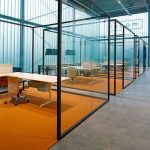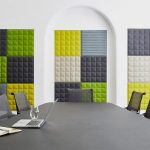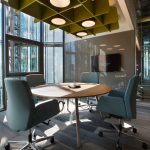
25 May Designing your office space for optimal Acoustics
When you look around your office space what do you see? Walls, ceiling, floor, lights, desks, chairs, computers, partitions, hutches, filing cabinets? How many of those surfaces do you think reverberate sound, and how many absorb it? The truth is, most of the surfaces you’ll find in an office space are hard surfaces. Wood, laminate, metal, dry-wall, hard-plastic, and glass surfaces all provide the ideal trampoline for noise to bounce off, which when mixed with direct sound, can wreak havoc on concentration and effective communication.
The traditional office space with carpeted floors, high cubicle partitions and low ceilings might have been great at limiting noise pollution; However the dark, closed-in environment it creates sends flashbacks to poor Milton and his beloved red stapler in the 1999 cult comedy Office Space. Hence the growing adoption of open-plan office spaces which encourage collaboration and provide a brighter working environment.
You’ve seen the photos. Google, Airbnb, Hootsuite; the list of tech companies paving the way of the open-plan office space, goes on for days. And while the look and casual feel of an open-plan office is enticing more and more ‘traditional’ organisations, often the issue of noise pollution is overlooked while designing the space. Take the fishbowl conference room for example. A box of floor to ceiling glass might act as a stunning feature piece for an office space, but did you know glass projects sounds more than any other substance?
How many times have you dialed into a meeting and the echo coming from the conference room has made it so hard to hear what’s going on, that you hang up feeling you’ve wasted an hour of your day? Failing to consider acoustics when designing an office can have a detrimental affect on productivity and employee morale.
The Solution
The good news is, you don’t need to turn your office into a padded cell to keep your acoustics in check.
Long gone are the days of generic fabric walls and partitions being an afterthought. When designing your space, consider how acoustics can enhance the look of a modern space. Utilising furniture, wall panels, room dividers, hanging clouds and light shades of various shapes, colours and heights, to create feature spaces, walls or ceilings.
Click through the below gallery for a number of inspirational acoustic applications.
- Pair hard floors for thoroughfares with carpeted breakout areas and offices for balance.
- Adding panels and soft materials on hard wall surfaces dampen sound.
- Felt space dividers offer both functionality and breathtaking designs.
- Add funky fabric covered furniture to act as sound dampeners.
- Adding varying depth acoustic blocks balances high and low frequency sounds.
- Lower high ceilings by hanging ceiling clouds or grids, this will help absorb sound from echoing throughout the space.









No Comments